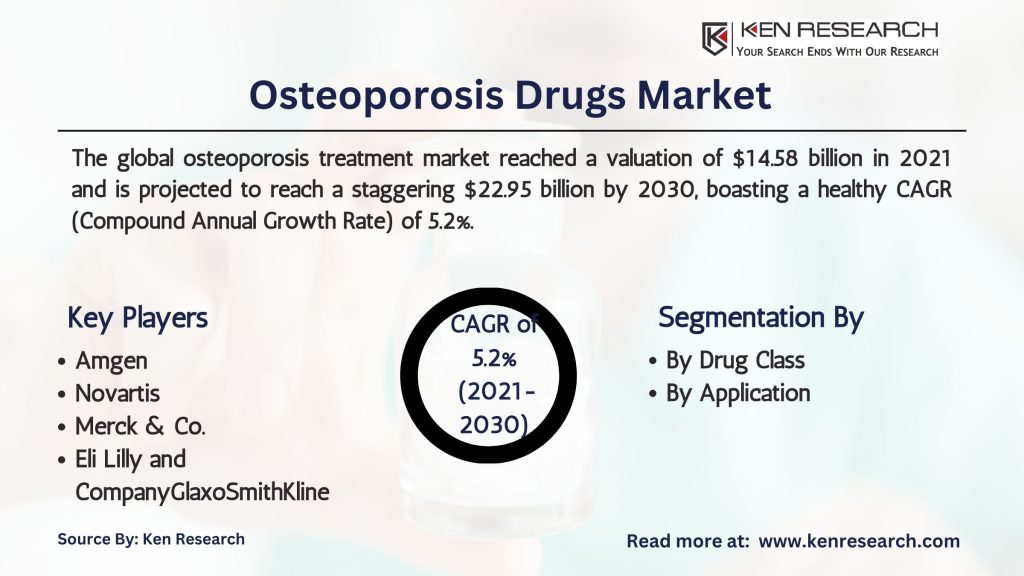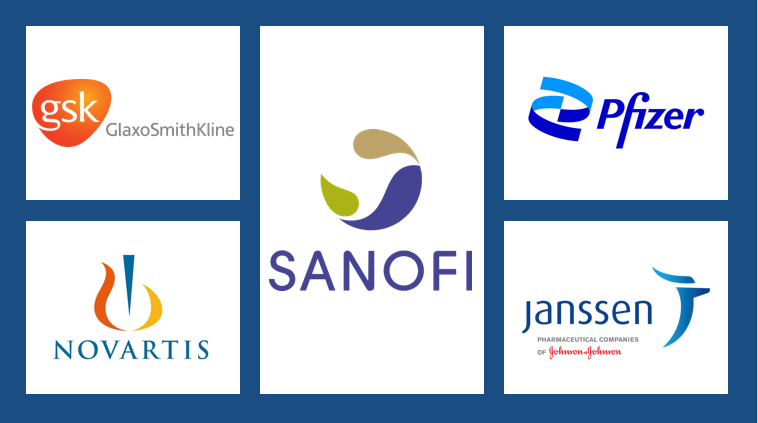Osteoporosis, a condition characterized by weakened and brittle bones, poses a significant health concern for millions globally.The osteoporosis drugs market, encompassing medications used to prevent and treat this condition, plays a crucial role in managing this chronic disease. This blog delves into the current state of the market in 2024, analyzing its size, segmentation, key trends, and future outlook.
A Market Supporting Bone Health

The osteoporosis drugs industry is driven by the growing prevalence of osteoporosis and the increasing awareness of its associated risks. The global osteoporosis treatment market reached a valuation of $14.58 billion in 2021 and is projected to reach a staggering $22.95 billion by 2030, boasting a healthy CAGR (Compound Annual Growth Rate) of 5.2%. This growth reflects the rising demand for effective treatment options and the increasing number of individuals diagnosed with osteoporosis.
Osteoporosis Drugs Market Analysis: A Segmented Approach
The osteoporosis drugs market segmentation based on various factors, allowing drug manufacturers to target specific patient populations and treatment needs:
- By Drug Class:
- Bisphosphonates: This established drug class remains the largest segment, with medications like alendronate (Fosamax) and risedronate (Actonel) being widely used to prevent and treat osteoporosis.
- Monoclonal Antibodies: Newer therapies like denosumab (Prolia) are gaining traction due to their high efficacy and convenient dosing schedules.
- Selective Estrogen Receptor Modulators (SERMs): These drugs, such as raloxifene (Evista), are primarily used for postmenopausal women to prevent and treat osteoporosis.
- Other Drug Classes: This segment includes calcitonin and parathyroid hormone analogs, used in specific cases of osteoporosis.
- By Application:
- Postmenopausal Osteoporosis: This segment accounts for a significant portion of the market due to the increased risk of bone loss in women after menopause.The global post-menopausal osteoporosis market is expected to reach $12.4 billion by 2030.
- Osteoporosis in Men: While less common, osteoporosis also affects men, requiring specific treatment approaches.
- Secondary Osteoporosis: This type of osteoporosis can occur due to underlying medical conditions or medication use, necessitating tailored treatment strategies.
Osteoporosis Drugs Market Trends: Shaping the Future of Treatment
Several osteoporosis drugs market trends are shaping the future are:
- Focus on Biologics: The development of new biologic drugs, like monoclonal antibodies, offers promising options with high efficacy and potentially fewer side effects compared to traditional medications.
- Personalized Medicine: A growing trend in medicine, personalized medicine involves tailoring treatment plans based on individual patient characteristics and genetic risk factors for osteoporosis.
- Telemedicine and Remote Monitoring: The utilization of telemedicine for consultations and remote monitoring of patients with osteoporosis can improve access to care and adherence to treatment regimens.
- Combination Therapies: Combining different drug classes or medications with lifestyle modifications like exercise and proper nutrition may become a more prevalent approach to manage osteoporosis effectively.
Take a look at: Osteoporosis Drugs Market: Booming at a 5.2% CAGR – What’s Driving the Growth?
Osteoporosis Market: Industry Competitors Vie for Market Share
The osteoporosis drugs industry competitors landscape comprises established pharmaceutical companies and emerging players developing innovative therapies. Some of the Top Players in the osteoporosis drugs market include:

- Amgen: A leader in the market with its blockbuster drug denosumab (Prolia).
- Novartis: Offers risedronate (Actonel) and other bisphosphonate medications.
- Merck & Co.: Markets alendronate (Fosamax), a widely prescribed bisphosphonate.
- Eli Lilly and Company: Provides raloxifene (Evista), a popular SERM for postmenopausal osteoporosis.
- GlaxoSmithKline: Offers various osteoporosis medications, including bisphosphonates and strontium ranelate (Compresst).
Opportunities in the Osteoporosis Drugs Industry: A Look Ahead
Several exciting opportunities in osteoporosis drugs industry are:
- Aging Population: The rising global population aged 65 and over is a significant driver of market growth as this age group is more susceptible to osteoporosis.
- Rising Awareness: Increased awareness of osteoporosis and its associated risks is prompting individuals to seek diagnosis and treatment.
- Development of Novel Therapies: Research and development efforts are focused on new drug classes and delivery methods with improved efficacy and safety profiles.
- Focus on Early Diagnosis: Early detection and treatment of osteoporosis can significantly improve patient outcomes, creating a demand for accurate diagnostic tools.
Challenges in the Osteoporosis Drugs Market: Hurdles to Overcome
While the future of the osteoporosis drugs market is promising, there are challenges in osteoporosis drugs market to be addressed:
- High Cost of Treatment: Osteoporosis medications can be expensive, potentially limiting patient access to these therapies.
- Compliance Issues: Long-term adherence to osteoporosis medication regimens can be challenging for some patients.
- Drug Safety Concerns: Some osteoporosis drugs, like bisphosphonates, have been associated with rare but serious side effects, requiring careful monitoring and potential development of safer alternatives.
Osteoporosis Drugs Market Report: A Roadmap for the Future
For a comprehensive understanding of the current and future state of the osteoporosis drugs market, consider consulting an osteoporosis drugs market report. These reports provide valuable insights into market size, segmentation, key players, trends, forecasts, and challenges, assisting healthcare professionals, pharmaceutical companies, and investors in making informed decisions.
Osteoporosis Drugs Market Future Outlook: A Focus on Innovation and Accessibility
The osteoporosis drugs market future outlook suggests a continued emphasis on innovation, affordability, and improved patient outcomes. Research and development efforts are likely to focus on:
- Developing safer and more effective drugs with fewer side effects.
- Creating long-acting injectable medications for improved adherence.
- Exploring the potential of gene therapies or stem cell treatments for bone regeneration.
- Finding ways to reduce the cost of osteoporosis medications to improve patient access.
Conclusion:
In conclusion, the osteoporosis drugs market presents significant opportunities for pharmaceutical companies to develop innovative therapies and address the unmet needs of patients with osteoporosis. By leveraging advancements in drug development, embracing digital health solutions, and prioritizing patient-centric care, industry players can drive growth and improve outcomes in the fight against osteoporosis. As we look to the future, collaboration between stakeholders across the healthcare ecosystem will be crucial in advancing research, promoting early detection, and optimizing treatment strategies for this debilitating condition.
You can also read about: Osteoporosis Drugs Market Analysis: Growth Trends, Segmentation, and Future Outlook

